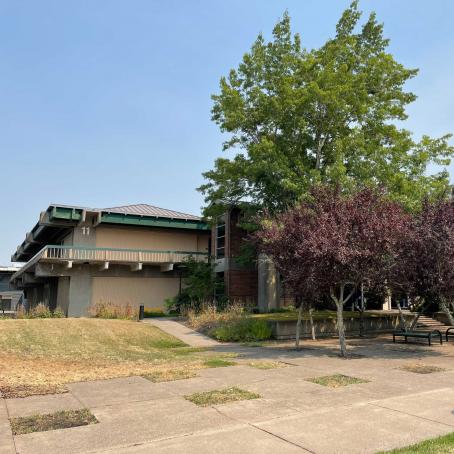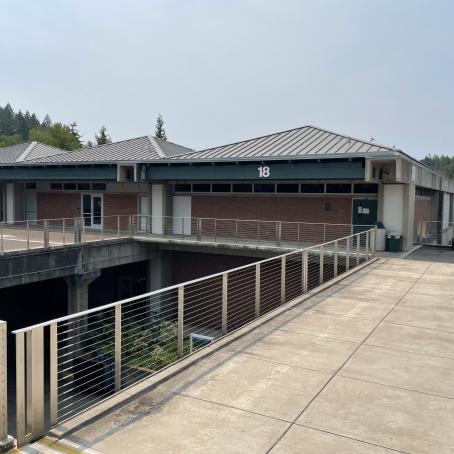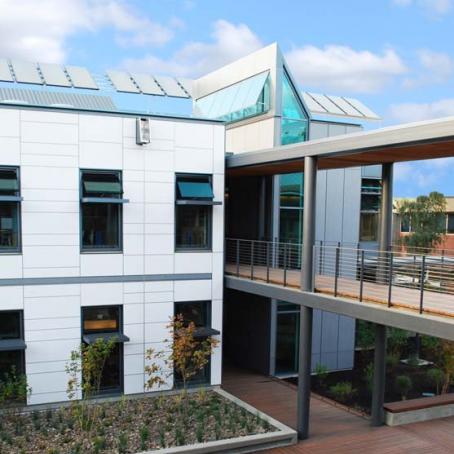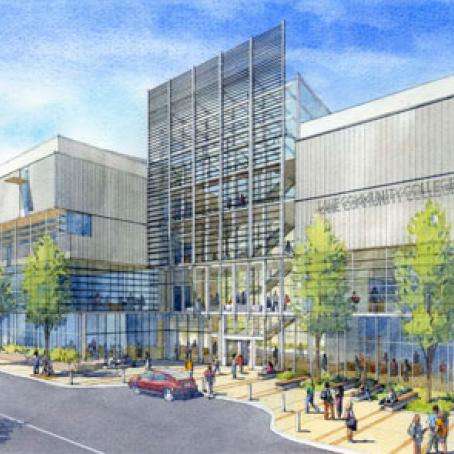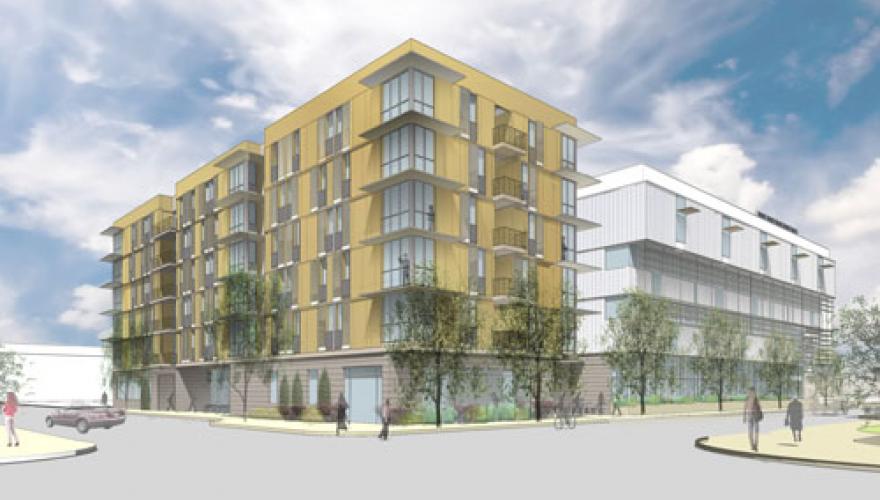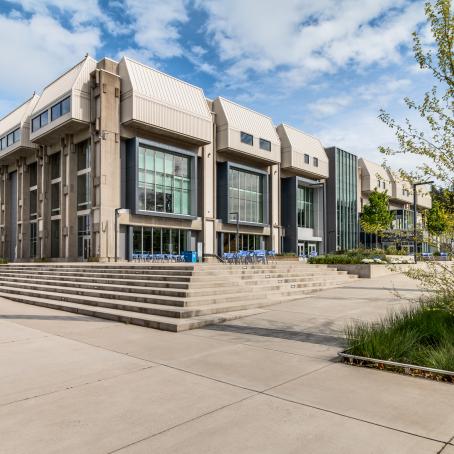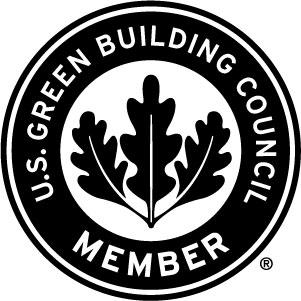Lane demonstrates its commitment to sustainability in its major construction and remodels. Since adopting the "Sustainability: Design and Construction" policy in 2006, all new construction has been LEED certified at the Gold level or higher and all major remodels have used LEED criteria as a guide for design. This page helps you learn more about our portfolio of high performance building projects.
Building 11
The 2013 Building 11 remodel consisted of interior reworking to provide several new classrooms spaces on the first floor and a new department suite and office for the Academic Learning Skills Division on the second floor. The project also involved significant modifications and upgrades to the mechanical systems. Lane did not attempt LEED certification in this small remodel, but did use LEED as a guide for design and construction. Green building aspects of this remodel include installation of new bike parking and two new bottle filling stations. The lighting and heating, ventilation, and air conditioning systems are more energy efficient. Insulation was added to new exterior walls making those walls up to 60% more insulating than required by code. New exterior windows are double pane and are significantly more insulating than the old single pane windows. The contractor recycled 80% of construction waste and four new recycling stations were installed for building occupants. Forest Stewardship Council certified wood was used for more than 50% of the total project wood use. Several of the construction materials also contained recycled-content including the linoleum flooring, the ceiling tiles, and the metal grid ceiling system. View a detailed report on Building 11 green building practices.
Building 18
The renovation of building 18 was started in 2017. The building is not LEED certified, however LEED standards were followed and used throughout the renovation project. The new renovations allowed for the Media Arts Department to converge to a single building, utilizing space in other buildings across campus more efficiently and decreasing their overall square footage. The renovation also increased safety by improving seismic resilience, reducing the potential loss of life in a seismic event. Another upgrade was on the second floor plumbing. All water fixtures in the second floor were upgraded, and there was a 20% reduction of water usage from LEED’s determined baseline rate. Energy use was also reduced with new HVAC upgraded to the equipment and controls. This resulted in saving of 33,272 kWh annually. Additionally, a reroofing project resulted in new insulation, further saving energy from heating and cooling costs. All lighting in the renovation area was switched to LED. Throughout this project, whatever could be salvaged was reused, and recycling was managed properly.
More about Building 18 renovation
Building 30
Building 30 received LEED Gold Certification on October 10, 2012. This project includes solar thermal panels that provide heated water for the faucet and building heating. This building uses about half of the electricity of a traditional building and about 30% less water.
Further Information About Building 30:
- The Building User Introduction Booklet that was created by the building architects and includes more in depth information about the green building features.
- The U.S. Green Building Council has information on green building and on the LEED Rating System.
Contact Luis Maggiori at (541) 463-5884 to schedule a group tour or for more information.
Mary Spilde Downtown Center
Lane's new Mary Spilde Downtown Center academic building opened in January 2013 and received LEED Platinum certification in 2014. The building is expected to use about half of the energy of a traditional building and over 35% less water. A green roof over the conference center helps to slow rainwater runoff. it acts as a sponge, absorbing the rainwater and slowly releasing it, reducing the necessary size of storm water systems while also filtering out impurities. All of the rain that falls on the other roofs is collected and stored in two 10,000 gallon tanks located below the West Courtyard. This rainwater harvesting system provides the water used to flush the toilets throughout the Mary Spilde Downtown Center. Geothermal wells provide the primary source of energy for heating and cooling. This system takes advantage of the constant temperature of the earth, which tempers the water that is circulated through the wells, minimizing the mechanical heating and cooling loads and reducing energy costs.
The LEED Scorecard details green features in this building. More about the Mary Spilde Downtown Center
Titan Court
Titan Court opened in September 2012 and received LEED Gold certification in 2014. This building uses 32% less energy than a traditional building and has a bike loan program for residents. The LEED Scorecard details green features in this building. More about Titan Court
Center Building - LCC Center for Learning Student Success
The Center Building at LCC’s main campus achieved LEED Silver Certification in July 2020 and was the result of major renovations completed as part of the 2008 LCC Bond.
The building uses 22% less energy by cost. Some of the energy efficiency measures included, higher efficiency air handling units, direct digital controls upgrade for Heating Ventilation and Air Conditioning (HVAC) systems, variable speed motor controls, high efficiency lighting systems, lighting controls, including occupancy and automatic daylight controls and increased daylight for all interior spaces. In addition, all of the public entrances to the building were designed with two sets of doors to minimize outside air intrusion.
The building uses 24% less potable water after the installation of the new plumbing equipment. The building’s plumbing fixtures were replaced for high efficiency fixtures. New toilets use 1.28 gallons per flush, new urinals use 0.5 gallons per flush, new faucets for lavatory use 0.5 gallons per minute and 1.8 gallons per minute for sinks.
To reduce the heat island effect from the building’s hardscapes, reflective materials were used in the surrounding plazas, such as light gray colored concrete. Resulting in a calculated Solar Reflective Index (SRI) of 34.
During construction, 98% of existing envelope and structural components in the building were kept and reused. Total percentage of construction waste diverted from the landfill was 95%, resulting in an exemplary performance score.
The project obtained an Innovation in Design (ID) pilot credit for Local food production. Raised planter beds installed to the East of the building, provide a bounty of fruits and herbs for students, staff and visitors. These beds area maintained organically following LCC’s Integrated Pest Management (IPM) plan
Resources
The U.S. Green Building Council has information on green building and on the LEED Rating System.

